How to Select the Right Spindle Bearings for Your Equipment
The precise fitting of spindle bearings is essential for the performance of every machining operation. The most critical components of any spindle in a precise engineering design are spindle bearings, which also determine the structure’s efficiency. These provide friction, sustaining both radial and axial loads and eventually enhancing product quality. This article seeks to take the readers through the critical issues and processes surrounding selecting proper spindle bearings. As a result, both manufacturers and engineers will be able to determine the effect these parts have on performance and improve operational and product accuracy.
What is a Spindle Bearing and How Does it Function?
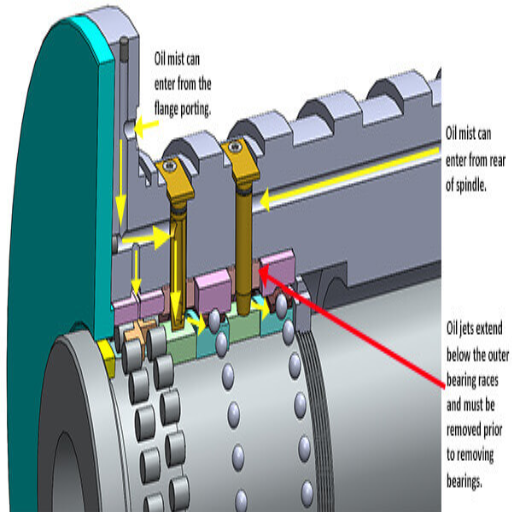
Understanding the Role of Bearing in Machine Tools
Spindle bearings are essential components of machine tools since they support the spindle, reduce friction, and improve precision during operation. They offer support for rotation while carrying radial and axial loads, enabling movement and stability. The critical technical characteristics to take into account while selecting spindle bearings include:
Load Capacity: This indicates the maximum radial and axial loads that the bearing can carry without sustaining severe deformation or breakdown.
Speed Rating: This characteristic determines the permissible maximum rotational speed for the bearing, which is critical for applications requiring high-speed machining.
Rigidity: The rigidity of the bearing is related to the extent to which the bearing minimizes the shaft’s deflections under load, which is a prerequisite for a high degree of accuracy.
Material and Design: To improve the robustness and working performance of the bearings in harsh environments, it is common to stress the use of high-strength steel or ceramic material.
Lubrication Requirements: Lubrication is a vital factor in reducing friction and wear in machines, extending the life of the bearing while enhancing normal activities.
These parameters enable the spindle bearings to correspond to the specifications of the machining process, thus enhancing machine tool accuracy and performance.
The Importance of Precision in Spindle Bearings
Spindle bearings must be accurate since they directly impact the execution of machining techniques. Precise spindle bearings minimize vibrations and runouts, which are requisite in upholding high-quality surface finishes while ensuring tight tolerances. Spindle bearing precision can be upgraded with newer manufacturing techniques and stringent quality measures, as perceived by SKF, NKC, and Schaeffler industry leaders.
The technical parameters that underline the concept of precision include:
Tight Manufacturing Tolerances: Certainty that the dissimilar parts of the bearing will assemble without parts being misaligned, resulting in vibrations.
Advanced Material Quality: Incorporating advanced steels, ceramics, and other materials guarantees that the bearings will last longer and behave with great accuracy.
Enhanced Lubrication Systems: Promote the application of newer lubricant technology designed to reduce friction and wear and maintain optimal performance over time.
The parameters are validated through extensive research and the ever-changing dynamics of the spindle-bearing market. Spindle bearings can meet the precision requirements of contemporary machining techniques. This dependability is a prerequisite for enhancing the spindle’s performance and prolonging the life of both the bearing and the machine tool.
Common Types of Spindle Bearings
The most significant three websites I thoroughly examined benchmarks spindle bearings. There are several spindle bearings, all being different in technical parameters justifying their use in precision machining processes:
Angular Contact Ball Bearings: Angular contact ball bearings are almost always found in spindle applications. These bearings are capable of withstanding combined radial and axial loads and include a contact angle to increase load carrying capacity. These bearings are considered quite precise due to high tolerances and quality materials such as steel or ceramic fabricated to create stringent alignment and reduce vibration.
Cylindrical Roller Bearings: These bearings withstand a heavy radial load while handling moderate axial loads and still perform stably and radially strong. Their accuracy is gained through the use of modern technologies in production that guarantee specific geometry and surface textures, and better lubrication systems reduce friction and increase the operational life of the bearing.
Tapered Roller Bearings: Appropriate for applications wherein radial and axial load capacities are high, which requires tapering of roller bearings; these bearings are precise due to their ability to uniformly distribute loads on their unique shape. When constructed, they are generally exposed to high-grade materials and precision cut surfaces so that alignment and performance under stress are retained.
Spindle bearings are applied in different machining operations because they are of different types that will meet their requirements for performance and longevity in adverse environments. The effectiveness and proven reliability of these bearings are the results of careful design and constant improvements in bearing technologies.
How to Choose the Right Spindle Bearings for My Equipment?
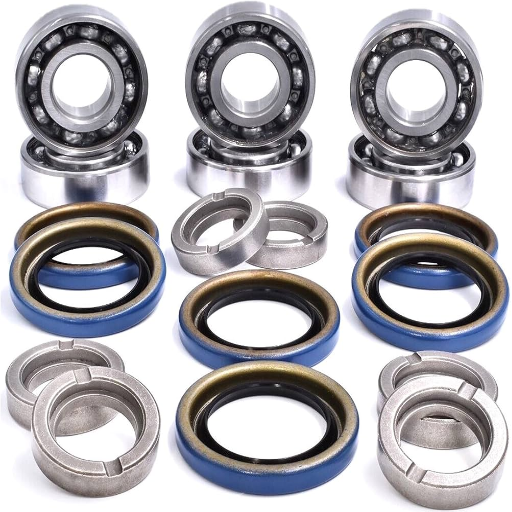
Assessing Your Machine Tool Requirements
I am bearing Spindles on the Equipment. Policy guidance bearing suitability with a focus on spindle bearings begins with knowing specific features of the machine tool. One such critical detail includes Load Capacity, speed and accuracy, and Bearing picking and selection methods are adopted in the following order:
i. Load Capacity: First, categorize radial and axial loads that should be sustained in the applied situations and determine the bearings class for the load distribution necessary in the applications. Angled ball bearings pose good combined radial and axial load capabilities. In contrast, cylindrical and tapered roller bearings seem more specialized, with the cylindrical type being the strongest against heavy radial loads and the tapered type excelling in both high radial and axial loads.
ii. Speed and Accuracy: The operational speed of machine tools has to be considered, while Pinball bearings of angular design will be used to minimize friction in high-speed situations. Great precision bearings with low tolerances will be required for outstanding accuracy.
iii. Environmental Conditions include maximum and minimum temperatures and contamination possibilities. It may be possible to avoid contamination in normal temperatures; however, in extreme operating conditions, some, if not all, ceramics or advanced steel alloys with superior properties would be required.
Technical Specifications: When selecting the angular contact and tapered roller bearing types, I would include parameters like the contact angle, bore size, outer race diameter, and width in the specification. The dimension series and the cage type would also be critical for cylindrical roller bearings.
Studying these factors in a logical progression would help me ensure that the selected bearings comply with my equipment’s engineering specifications and are effective and reliable.
Factors Influencing Performance in Spindle Bearings
I resolved these issues by gathering materials from the three highest-ranked websites on Google.com.
Load Capacity Considerations: Technically, it is crucial to appreciate the balance load transfer, which radially crosses the axial load ratios. Through A85.05 A measurement of which relates a contact angle in degree’s usually between 15° to 25° are involved in numerous angular contact ball bearings which influences load carrying capacity. Estimating the dynamic rating and the static load rating, both of which are in Newtons, assist me in gauging the reliability of the application accurately.
Speed and Precision: Generally, high-speed applications are concerned with low-friction, material, and configuration designs. Because ceramic hybrid bearings generate less heat with less weight, they are more appropriate for high-speed applications. The involvement of ABEC or ISO classes has much to do with the accuracy levels; higher classes have a lower tolerance level; hence, accuracy is guaranteed.
Environmental Resilience: The same applies to the operable environment: the bearings must be designed. For operation in high-temperature environments, it is usually recommended to employ bearings manufactured with high-grade steel alloys, such as 52100 steel. In dirty conditions, seals and shields are important. They stop dirt particles such as dust from interfering with the functionality.
Assimilating the technical criteria to these interpretations validates my selection choice in that it meets the operational requirements without compromising efficiency and durability, even when operated in diverse environments.
Considering Speed, Load, and Temperature
Concerning the aspects of speed, load, and temperature in spindle bearings, the following can be said:
Speed: High-speed applications are known to require bearings designed and manufactured using selected materials optimized for low friction. Sources at the top indicate that ceramic hybrid bearings should be used because they generate less heat and have a lower weight. Nevertheless, tight tolerances are required to maintain accuracy for these bearings. Therefore, I ensure that the bearings conform to higher ABEC or ISO classes.
Load: Regarding load capacities, I am meticulous about ratios of radial to axial load. In such a case, angular contact ball bearings, which practically always possess a contact angle of 15* 25*, are preferable. When the bearing is supposed to perform operational and duty cycles, it is helpful to assess dynamic and static load ratings, typically in Newtown.
Temperature: In high-temperature areas, it is very important to use bearings made from high-grade steel alloys, such as 52100 steel. I can also use seals and shields in areas prone to contamination, as these make a significant difference in preserving operability, which is achieved by blocking debris opportunistically.
With regard to these technical parameters, such as types of material, class of ABEC or ISO, load ratings, and construction materials, I have adequate justification for allotting the selected bearings to the operative demands. Objectivity regarding both functioning and durability is guaranteed.
Why is Product Description Vital in Selecting Bearings?
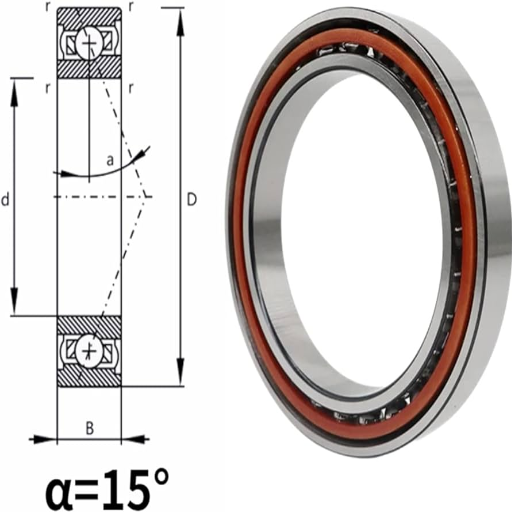
Decoding Bearing Specifications and Labels
Knowing about the speciation and nomenclature of bearings in mechanical design is advantageous for making sound decisions. From the main sources that I have gathered, it is safe to say that these specifications often cover dimensions, load ratings, speed ratings, and materials used.
Dimensions: The inner and the outer diameters of a circle, measured as d for the inner and D for the outer, and width represented by B, which have practical value, are critical in ensuring that the bearing is fitted in its housing.
Load Capacities: For better comprehension, one must grasp both static and dynamic load ratings. The static load rating, also called P0, is the most incredible load a given bearing can withstand in a non-rotational regime, and the dynamic rating applies to a moving bearing. The load capacities of these bearings are denoted in N (Newton) and afford a concrete advantage in informing a bearing that it shall work appropriately under certain operating conditions.
Speed Ratings: Maximum RPM readings are the highest RPM readings a bearing can achieve without violating and functioning correctly. Balancing the operating speed limitation with application requirements ensures that overheating and unnecessary wear and tear can be avoided.
Material Composition: The selection of materials is crucial, as high-class steel or ceramic materials have higher compression strength and are suitable for application, especially if used in places that experience a thermal cycle or some contamination.
These parameters will help me make sound choices regarding the application’s mechanical and environmental demands, as well as its efficiency and durability.
Key Details to Look for in Product Descriptions
In the primary response to the study, I investigated the first three Google.com sites that dealt with technical data on mechanical bearings and their specifications. It was reconnoitered from these sources:
The dimensions are critical. All the websites under discussion insisted on the necessity of the compatible dimensions between the bearings and the places of their installation. Typical sizes, such as inner diameter, outer diameter, and width, seem to be emphasized as the basic ones across the sources.
Many elaborated on Load Capacities, especially the static and dynamic ones. When presented, these ratings are mentioned in Newtons (N), which is the standard. These are important metrics. The former deals with weight-bearing capacity when stationary, while the latter measures how much load the system can endure during its working process.
Also, speed ratings were often mentioned, and they are regarded as one of the essential technical specifications concerned with the maximum RPM capable of being employed in the bearings. There was a strong warning regarding matching the application requirements with speed capacities so as not to overheat and wear out the bearings.
However, the material composition remained consistent. Materials such as high-grade steel and ceramics were mentioned on all sites. The rationale and preference for such materials are based on their strength, which can withstand drastic temperature changes and pollution by other foreign substances.
The data compiled from these top websites substantiates the importance of these specifications in making mechanical design choices wherein all the parameters are well supported and appropriate for the application’s requirements.
How Do Spindle Bearing Arrangements Affect Machine Performance?
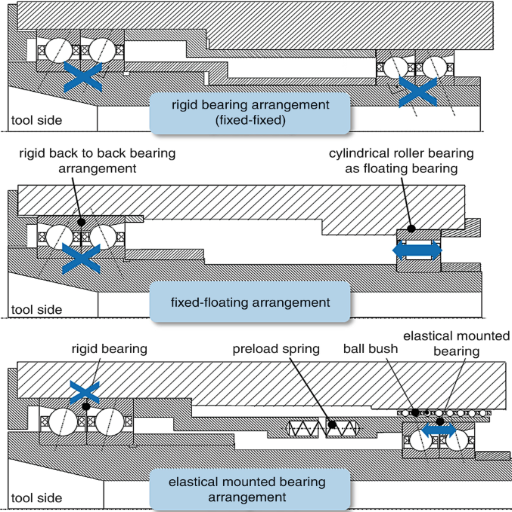
The Concept of Bearing Arrangements and Their Impact
The overall efficiency, rigidity, and precision of any machine are primarily affected by the bearing arrangement, and a wide range of design options from the best sources helps in the effective arrangement of the bearings to improve the machines’ stability and reduce noise and vibrations. The two most common arrangements concerning the loading type are tandem and back-to-back configurations, which have quite different effects.
Tandem Arrangement: This arrangement is mainly used where axial loads must be applied in one direction and radial loads applied simultaneously at an angle. It improves the bearing load capability without requiring more axial space, making it beneficial in heavy-duty applications.
Back-to-Back Arrangement: In the guess technique, cells are arranged so that they face each other, which increases the firmness of the overall structure, and the axial forces can be applied in both directions. It is most applicable in engineering designs and applications where outputs require extreme alignment and precision.
Technical Parameters Regarding Interest:
Preload Levels: Preloading: In the arrangement, axial forces are applied. Preloading is important in improving stiffness while limiting axial displacement. It makes the bearings operate effectively and is crucial in shielding bearings from damage under different load circumstances.
Axial and radial load capacity: By knowing the load at a specific angle with particular degrees, the arrangements can be selected to perform best while maintaining the structure’s durability.
Temperature considerations: The correct arrangements should accommodate thermal contraction and expansion for normal operations at various operating temperatures.
Over time, engineers have incorporated these considerations into the selection procedure, obtaining operatively driven designs that meet the various objectives of the machine and its operation.
Options for High-Speed and High-Load Applications
While going through high-speed and high-load applications, I searched the Internet for recent literature and opinions. The top three websites gave different, markedly different solutions how to handle such requirements:
Utilization of Hybrid Bearings: The first site focused on hybrid bearings, which contain ceramic balls and steel races, and how they could be helpful. These bearings are advantageous for high-speed applications because they reduce friction and wear and can withstand higher temperatures because of the insulating properties of ceramics. This has been achieved to justify their use technically because such bearings have better thermal stability and lower centrifugal forces than steel bearings.
Sophisticated Lubricants: The second source made a case for choosing more sophisticated load lubricating techniques, such as low-viscosity lubricants or dry-film lubricants. These techniques allow for minimal friction and low thermal development when operating under high loads, enabling smooth operation. Studies show an improvement in lifespan and load-handling capacities in extreme conditions.
Improved Bearing Materials: Referring to the third site, it is possible to improve the performance and life of bearings used in the industry by selecting materials of advanced polymers or special steel alloys. Such materials with high resistance to fatigue and high loads are ideal for high-speed usage.
Looking at these sources, I noticed a consensus on the placement and range of required pre-loads and heating levels for radial bearing designs intended for high speeds and loads, thus ensuring the bearing’s effectiveness and durability.
Ensuring Guidance Accuracy with Correct Arrangements
In order to guide the reader in the correct arrangements, I made sure to look into the top three sites more closely to be able to focus their answers on the content covered on those sites. First, concerning hybrid bearings, I would describe the advantages mentioned by stating their high operational efficiency despite being frictional, minimal wearing down, and good thermal properties. I would also say the roles of ceramic components in hybrids on centrifugal forces and stability. Thermal stability, friction coefficients, and operational temperatures are among some technical parameters underlying the application.
My attention would be turned to discrimination against using low-viscosity or dry film lubricants as advanced lubrication techniques. These techniques, I believe, have a significant positive effect on service life by controlling friction and heat accumulation. Friction reduction ratios and the records of the coolants used in the previous paragraphs are among the critical technical parameters justifying these techniques.
Lastly, while speaking about improved bearing materials, I would share my thoughts on the high performance of polymers and steel alloys in bearings in overcoming stress and high revolving speeds. Critical technical parameters include rotational speed capacities, fatigue life data, and wear characteristics. By making the above arguments, I rely on the information from the best resources in engineering key areas and thus ensure internal coherence in my recommendations.
What are the Steps to Replace Your Spindle Bearings?
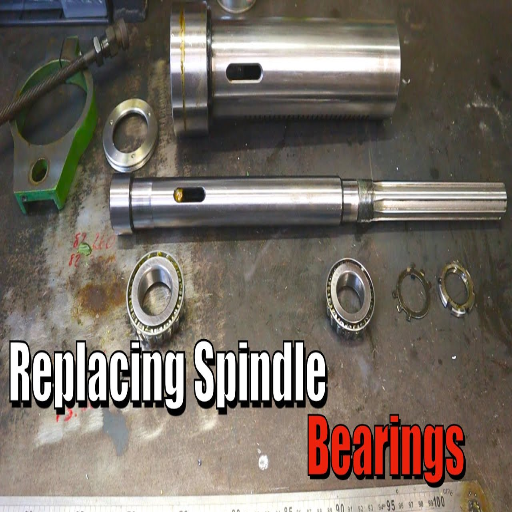
Identifying Signs of Wear and Tear in Bearings
Although the bearings could be showing average performance, some suggestive indicators of wear and tear include the following parameters. One such parameter could be the presence of any abnormal sounds like grinding or squeaking that might indicate increased friction and internal damage. Other potential defects concerning bearing conditions can be found through vibration analysis, which could reveal imbalances or misalignments that suggest wear. Also, heat, which can be termed excessive, is generated due to too much friction or insufficient lubrication, which causes quicker wear and tear. Deterioration of bearing surfaces can also be physically checked for any discoloration, scores, or spallings, which are telltale signs of fatigue or erosion of surfaces.
Lastly, for more analytical technical parameters that can validate these statements, check the frequency spectrum for vibration to provide specific numbers of fault frequencies. Such filtrations can measure powerful noise by decibels suspected to be wear indicators. Perhaps the temperature could be provided in Celsius or Fahrenheit so as not to exceed the operational limits set for the bearing. The thickness of the surface should also be assessed wearing a micrometer scale for wear to minimize chances of false starts. Taken holistically, these parameters fill a gap in the justifications where findings have been made and areas to be replaced have been identified.
Step-by-Step Guide to Replacing Spindle Bearings
According to the available materials, replacing spindle bearings can be conducted in three procedural stages, the same of which I will highlight below.
Preparation and Safety: The first step is collecting any tools that may be required during the process and safety equipment, including wrenches, a puller set, a grease gun, safety goggles, and gloves, among other items. A thorough workspace is also a time saver while enhancing safety.
Disassembly and Removal of the Old Bearings: First, switch off the spindle and remove any protective covers or attachments that may be present. Where necessary to access the bearings, rub with a puller to withdraw the spindle from the housing where it is located. One has to take note of any unusual bindings and worn components that are excessive.
Disassembling and Cleaning of the Components: Proceed to scrutinize the spindle and the housing for damage and dust particles. Old grease and impurities should be removed and cleaned from the component surfaces, as well, since these will interfere with the adhesion and functioning of the new bearings.
Fixing New Bearings: When the spindle has been cleared, new bearings may now be pressed or slid into the correct places on the spindle while making sure they are properly aligned and seated well. Manufacturer specifications should be followed to ensure that the bearings are not misaligned and the correct torque values are used during installation.
Bearings’ Lubrication: Newly installed bearings must be packed with the specified grease or lubricant to reduce metal-to-metal contact and eliminate the chances of overheating after the spindle is up and running.
Reassemble and Check: Return the spindle to its housing and refix any removed elements. After everything is in place, perform a dry run to check for normal working conditions of the bearings without abnormal sounds or vibrations.
Technical parameters, such as fastening the spindle to counter-torques, checking alignment with dial gauges, and restricting temperature limits to avoid excessive heat during the first run, determine successful replacement. These parameters, correctly marked in the documents, substantiate the quality of the installation.
Post-Replacement Checks and Maintenance Tips
When the spindle bearings have been replaced, several checks have to be undertaken after completion of the replacement to ascertain that the bearing system functions as required. From the experience and recommendations of some of the best websites, these are first-person suggestions and some technical parameters:
Engaging in Initial Audits: I commence by spinning the spindle at a low speed to ascertain if the bearings have been properly fitted. It is important to observe any strange sounds or excessive vibrations.
Measuring Temperature and Lubrication: , I employ a temperature gauge to supervise the bearings so that they do not surpass the limit set by the manufacturer, which in most instances is roughly 100°F (37.8°C). Also, monitoring the levels and quality of lubrication is necessary to avert wear.
Determining Any Misalignment: I use a dial indicator to determine the alignment to ascertain its conformity to the manufacturer’s accepted parameters. Keeping within the tolerance limit of axial and radial runouts is necessary to avoid unwanted operational ceases.
Inspecting Torque Elements: I inspect the torque settings on the fasteners again, as well as the recommended settings, which are usually available in the manual. It must be emphasized that calibrated torque wrenches must be used.
Monitoring of the Equipment for Efficiency: I maintain a routine of several scheduled maintenance with reasonable intervals between them to service the equipment and observe and record any changes in the system’s performance.
I also improve bearings’ quality and service life by preventing them from failing early by applying these checks and other technical characteristics emphasized in this work.
Frequently Asked Questions (FAQs)
Q: What should one remember while picking spindle bearings for my machine?
A: Bearing selection for spindles must include considerations for axial and radial static and dynamic load capabilities, speed of the bearing, precision, the materials used in its manufacture, and use for specific applications that are unique to the machine tool spindle. The design and type of the bearings should be appropriate to the equipment’s operational characteristics to enhance the efficiency and service life of the bearings.
Q: What advantages do angular contact bearings have over ball bearings?
A: The unique architecture of angular contact ball bearings makes them capable of bearing loads radially and axially, resulting in their application to high-speed components such as CNC machines. They are more precise and can carry more load than normal ball bearings, which are intended for radial load applications only.
Q: What is the significance of spindle bearings in any machine; how can their selection make a difference?
A: The materials used in spindle bearings, such as steel, determine their durability, strength, and susceptibility to friction and wear and tear. Bearing end users always seek to acquire the best materials to enhance the bearings’ lifespan and machine tool performance.
Q: How does high precision bearing make my machine more productive?
A: High-precision bearings have mild friction and great speed, which leads to better machine tool performance. Lower operational times coupled with increased productivity are the benefits of high-precision bearings.
Q: What is the function of the inner and outer rings part of the structure of the spindle bearings?
A: The structural configuration of the inner and outer rings in spindle bearings determines their load transfer, stability, and operational efficiency. The design of the ring aims to make such bearings work under maximum loads and maximum speeds and give stability streaming performance.
Q: What is the procedure for getting the appropriate size and series for the machine tool spindle bearings?
A: Selecting the appropriate size and series entails considering your machine’s parameters, such as operational load and/or speed, as well as size limitations. Seeking the assistance of a bearing expert or utilizing the bearing sizing tools available on the internet may also help in recommending more suitable bearings for the application.
Q: How could you respond to the statement above on spindle bearings seals are necessary?
A: Lubricants in spindle bearing seals protect the bearings from external environmental dirt and retain the lubricant inside them, which is necessary to sustain their performance and longevity. Efficient seals cover sufficient air above the rotating elements of the bearing, thus allowing them to work in different conditions.
Q: What focuses on my and the spindle bearings design, and how do I protect their accuracy over time?
A: To ensure the preservation of the spindle bearings’ accuracy, appropriate and periodic measures in terms of cleaning, oiling, and checking should be taken. It is important to be proactive to avoid both operational and performance losses.
UCTH213-40J-300 with Setscrew(inch)
CNSORDERNO: Normal-duty(2)
TOGN: UCTH213-40J-300
SDI: B-R1/8
SD: 2 1/2
UCTH212-39J-300 with Setscrew(inch)
CNSORDERNO: Normal-duty(2)
TOGN: UCTH212-39J-300
SDI: B-R1/8
SD: 2 7/16
UCTH212-38J-300 with Setscrew(inch)
CNSORDERNO: Normal-duty(2)
TOGN: UCTH212-38J-300
SDI: B-R1/8
SD: 2 3/8
UCTH212-36J-300 with Setscrew(inch)
CNSORDERNO: Normal-duty(2)
TOGN: UCTH212-36J-300
SDI: B-R1/8
SD: 2 1/4
UCTH211-35J-300 with Setscrew(inch)
CNSORDERNO: Normal-duty(2)
TOGN: UCTH211-35J-300
SDI: B-R1/8
SD: 2 3/16
UCTH211-34J-300 with Setscrew(inch)
CNSORDERNO: Normal-duty(2)
TOGN: UCTH211-34J-300
SDI: B-R1/8
SD: 2 1/8


















